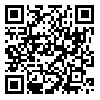Volume 13, Issue 4 (Winter 2006)
J Birjand Univ Med Sci. 2006, 13(4): 9-15 |
Back to browse issues page
Download citation:
BibTeX | RIS | EndNote | Medlars | ProCite | Reference Manager | RefWorks
Send citation to:



BibTeX | RIS | EndNote | Medlars | ProCite | Reference Manager | RefWorks
Send citation to:
Moodi M, ZamaniPour N, SharifZadeh G, Akbari-Bourang M, Salehi S. Evaluating Puberty health program effect on knowledge increase among female intermediate and high school students in Birjand. Journals of Birjand University of Medical Sciences 2006; 13 (4) :9-15
URL: http://journal.bums.ac.ir/article-1-114-en.html
URL: http://journal.bums.ac.ir/article-1-114-en.html
1- Instructor, Depatment of Health Education, Birjand University of Medical Sciences, Birjand, Iran , mitra_m2561@yahoo.com
2- B.Sc in Family Health, Birjand University of Medical Sciences, Birjand, Iran
3- Instructor, Depatment of Social Medicine, Birjand University of Medical Sciences, Birjand, Iran
4- M.Sc in Education Technology
5- B.Sc in Public Health
2- B.Sc in Family Health, Birjand University of Medical Sciences, Birjand, Iran
3- Instructor, Depatment of Social Medicine, Birjand University of Medical Sciences, Birjand, Iran
4- M.Sc in Education Technology
5- B.Sc in Public Health
Abstract: (24900 Views)
Background and Aim: Puberty is one of the most critical period in a female adolescents' life. During this period, in addition to consideration of the girls' social problem and relationships, it is necessary to pay close attention to the health problems of puberty and get them aquainted with puberty health necessities. This intervening study aimed at evaluating the effect of educational program for puberty health on improving intermediate and high school female students' knowledge in Birjand.
Materials and Methods: In this quasi-experimental study, 325 female intermediate and high school students were selected through randomized cluster sampling during several stages. Then, a self-set questionnaire including 20 questions, each having one point regarding puberty health, was distributed among them. After being filled out, the questionnaires were gathered. Following this, under a systemic educational plan all intermediate and high school selected students were given the same instruction by trained instructors. Instruction time for each meeting was estimated 1.5 hours. One month after the educational program and handing out the pamphlets in schools, the previous questionnaires were again distributed among the students to fill out, then, they were gathered. Those students who, for whatever reason, had avoided to fill out the questionnaires were omitted from study. At the end, 302 students who had filled out the questionnaires before and after intervention were studied. The obtained data were analysed by statistical paired Student t-test at significant level of P0.05.
Results: Out of 302 students, 151 were intermediate and 151 high school students. Knowledge level among intermediate students was estimated 5.033.7 before intervention and 10.84.8 after intervention. Among high school students, the scores were 4.12.3 and 8.73.8, respectively. There was a significant difference between pre-intervention stage and post-intervention stage in both groups (P<0.001). Also, mean knowledge grade in all the students under study increased from 4.63.1 before intervention to 9.74.4 after intervention (P<0.001).
Conclusion: Performing educational programs during puberty has a crucial role in young girls' knowledge increase. Since young girls often do not share their problems with their parents and their peers during the period, instructional classes in schools provide a good oppotunity for them to present their problems and finding solutions.
Materials and Methods: In this quasi-experimental study, 325 female intermediate and high school students were selected through randomized cluster sampling during several stages. Then, a self-set questionnaire including 20 questions, each having one point regarding puberty health, was distributed among them. After being filled out, the questionnaires were gathered. Following this, under a systemic educational plan all intermediate and high school selected students were given the same instruction by trained instructors. Instruction time for each meeting was estimated 1.5 hours. One month after the educational program and handing out the pamphlets in schools, the previous questionnaires were again distributed among the students to fill out, then, they were gathered. Those students who, for whatever reason, had avoided to fill out the questionnaires were omitted from study. At the end, 302 students who had filled out the questionnaires before and after intervention were studied. The obtained data were analysed by statistical paired Student t-test at significant level of P0.05.
Results: Out of 302 students, 151 were intermediate and 151 high school students. Knowledge level among intermediate students was estimated 5.033.7 before intervention and 10.84.8 after intervention. Among high school students, the scores were 4.12.3 and 8.73.8, respectively. There was a significant difference between pre-intervention stage and post-intervention stage in both groups (P<0.001). Also, mean knowledge grade in all the students under study increased from 4.63.1 before intervention to 9.74.4 after intervention (P<0.001).
Conclusion: Performing educational programs during puberty has a crucial role in young girls' knowledge increase. Since young girls often do not share their problems with their parents and their peers during the period, instructional classes in schools provide a good oppotunity for them to present their problems and finding solutions.
Type of Study: Original Article |
Subject:
Health Education
Received: 2006/09/6 | Accepted: 2016/03/10 | ePublished: 2016/03/10
Received: 2006/09/6 | Accepted: 2016/03/10 | ePublished: 2016/03/10
Send email to the article author
| Rights and permissions | |
 |
This work is licensed under a Creative Commons Attribution-NonCommercial 4.0 International License. |





